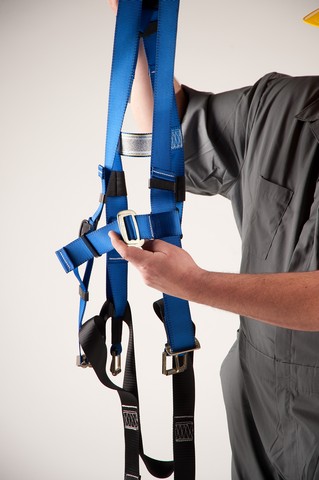
Improper Use of Your Safety Harness Can Be a Costly Mistake
January 26, 2024
The effectiveness of any fall protection system depends on the proper use of each component. Improper use, carelessness or use of a damaged harness can result in death or severe injury, as well as damage to equipment and the work environment. The full-body safety harness is an integral part of a modern fall protection system if you utilize it correctly.
Four Safety Harness Mistakes to Avoid
Businesses can avoid serious accidents or injuries by steering clear of these common errors.
Failure to Perform Proper Inspection
It is important for workers to inspect their harnesses before every use. Hurried, incomplete, or improper equipment inspection can mean overlooking a critical sign of fatigue or damage. Check for a tag or label for information about the previous condition and inspection date. No worker should attempt to don or use a harness that did not pass an inspection. Dispose of any failed equipment to ensure they are not used again. Check the webbing, D-rings, grommets, belts, and buckles thoroughly for compromised integrity, deformity, and worn condition.
Failure to Don the Harness Properly
Workers need to know how to put on a safety harness correctly. Misuse of a body harness through neglect or ignorance greatly reduces the equipment’s ability to provide sufficient protection. Be sure that the D-ring is properly positioned and that there are no twists, snags, or tangles in the straps.
Additionally, workers must understand how to wear a safety harness tightly. They need to check that buckles fasten properly and check for any slippage. A snug harness is an effective harness.
Improper Fit
A body harness that is not properly adjusted for fit is almost as dangerous as working without any harness at all. A snug fit on both the top and bottom sections of the harness is essential. Slipping loose from one portion of the harness while working at height can leave a worker in a perilous situation requiring urgent rescue. Traumatic injuries, organ damage, and neurological injuries can result after only minutes of prolonged suspension in some cases.
To ensure a proper harness fit, workers need to select a weight-appropriate harness. Weight limits are specific to each make and model of harness, though the typical range is between 130 and 310 pounds (weight includes the harness itself, the worker’s clothing and any tools the worker will be using on the job). For obvious reasons of safety, harness weight limits should not be exceeded and body harnesses should not be used to lift materials or equipment.
Overuse
Know when enough is indeed enough. A harness that has exceeded its typical 5-year working life should be discarded if it shows any signs of wear or aging. Workers should check not only inspection dates but also the date at which the harness entered service. A harness that has exceeded its work life may risk equipment failure, even though it may display no obvious signs of fatigue, damage or wear.
What Are Harnesses Used For?
Different jobs at height require the use of a harness. The oil and gas industry uses harnesses for ladder climbing, but this safety equipment can safeguard workers in various sectors when climbing towers, welding, or moving through confined spaces.
Although many kinds of full-body safety harnesses accommodate different industries’ demands, they’re all purpose-built to avoid falls. To execute intricate work at height, workers will need a full range of motion and can opt for a positioning harness with seat support, side D-rings, and dorsal D-rings. Technicians working with utility infrastructure have different requirements and will need specific arc-resistant harnesses.
Not all jobs require a specialized harness. In some situations, a standard full-body harness might suffice. These harnesses do not have any specific material requirements other than ensuring a secure fall arrest.
Take Care of Your Gear
To ensure your full-body safety harness performs reliably, get to know your equipment — you need to know how to wear safety harnesses and how to use them properly. Taking care of your gear is also essential. Inspect your harness according to the inspection date. A thorough safety equipment inspection might be time-consuming, but it can minimize serious injuries.
Rigid Lifelines® manufactures durable full-body harnesses with dual fall indicators on the shoulder straps to simplify equipment inspections. Each harness also has a back D-ring for fall arrest and two side D-rings for positioning. Learn more about our harnesses or contact us online for more information about our safety equipment.
Categories
Share this post
Let us help you
Contact us today to find the perfect product fit for your job
